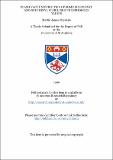Files in this item
Flash vacuum pyrolysis of some sulphonyl and sulphinyl stabilised phosphorous ylides
Item metadata
| dc.contributor.advisor | Aitken, R. Alan (Robert Alan) | |
| dc.contributor.author | Drysdale, Martin James | |
| dc.coverage.spatial | 184 p. | en_US |
| dc.date.accessioned | 2018-07-05T14:08:39Z | |
| dc.date.available | 2018-07-05T14:08:39Z | |
| dc.date.issued | 1990 | |
| dc.identifier.uri | https://hdl.handle.net/10023/15002 | |
| dc.description.abstract | The reaction between alkylidene or arylmethylene triphenyl phosphoranes and sulphonyl fluorides or sulphonic anhydrides has been used to give a variety of α-sulphonyl stabilised phosphorus ylides. Flash Vacuum Pyrolysis (FVP) of alkyl- and arylsulphonyl alkylidene triphenyl phosphoranes leads to two fractions. The first fraction is made up of up to 20 phosphorus containing products, the major one being Ph₃PO. The second fraction is a liquid at low temperature which forms a white, insoluble polymeric material on warming to room temperature. Trapping reactions of the liquid with Diels-Alder dienes or chlorine gives unknown and unstable compounds except with anthracene where an unidentified complex is formed. FVP of benzyl- and substituted-benzylsulphonyl alkylidene and phenylmethylene triphenyl phosphoranes proceeds by loss of Ph₃P followed by intramolecular insertion of the resulting carbene to form episulphones which lose SO₂ to give stilbene or styrene derivatives. In the cases where the phosphorane is an α-sulphonyl ethylidene triphenyl phosphorane, a 1,2-H shift of the carbene can occur to form a vinyl sulphone, which decomposes to vinyl and benzyl radicals and SO₂ with formation of bibenzyl products. Where the phosphorane is an α-sulphonyl ortho-substituted-benzylidene triphenyl phosphorane, a second carbene insertion pathway occurs to give eventually benzofuran or benzothiophene and bibenzyl. The Ph₃P group reacts with the liberated SO2 to give some conversion to a 2:1 mixture of Ph₃PO and Ph₃PS, a previously unrecognised reaction. The initially formed stilbene or styrene products can react to a certain extent to form cross over products under the reaction conditions used. A number of α-sulphinyl alkoxycarbonylmethylene triphenyl phosphoranes have been made from alkoxycarbonylmethylene triphenyl phosphoranes, sulphinyl chlorides and Et₃N. These ylides exhibit broadening in their ¹H and ¹³C NMR spectra, variable temperature NMR studies indicating the presence of cis and trans rotamers. FVP of these compounds gave Ph₃P, Ph₃PO, vinyl or substituted vinyl sulphides, alkyl sulphides and an as yet unidentified carbonyl compound. The vinyl or substituted vinyl sulphides are obtained via loss of Ph₃PO from the starting ylide followed by insertion of the carbene form of the initially formed thia-acetylene and loss of CO₂ from the resulting β-lactone. The other products are obtained from a variety of insertion, rearrangement and elimination reactions of the initially formed carbenes some of which have been elucidated with the help of ¹³C labelling. Isopropylsulphinyl benzylidene triphenyl phosphorane was synthesised and upon FVP gave Ph₃P, isopropyl thiobenzoate and thiobenzoic acid. The formation of isopropyl thiobenzoate is rationalised via an S to C oxygen transfer mechanism of the initially formed carbene, involving the intermediacy of the previously unknown λ⁴-oxathiirene ring system. A β-keto tri-n-butyl phosphorane, benzoyl butylidene tri-n-butyl phosphorane was synthesised and its FVP performed at room temperature, 300°C and 500°C. The almost complete extrusion of Buⁿ₃PO from the ylide at 300°C indicates that much lower temperatures are required for loss of Bun₃PO as compared to loss of Ph₃PO. | en_US |
| dc.language.iso | en | en_US |
| dc.publisher | University of St Andrews | |
| dc.subject.lcc | QD305.Y6D8 | |
| dc.subject.lcsh | Ylides | en |
| dc.title | Flash vacuum pyrolysis of some sulphonyl and sulphinyl stabilised phosphorous ylides | en_US |
| dc.type | Thesis | en_US |
| dc.contributor.sponsor | BP Chemicals International Limited | en_US |
| dc.type.qualificationlevel | Doctoral | en_US |
| dc.type.qualificationname | PhD Doctor of Philosophy | en_US |
| dc.publisher.institution | The University of St Andrews | en_US |
This item appears in the following Collection(s)
Items in the St Andrews Research Repository are protected by copyright, with all rights reserved, unless otherwise indicated.

